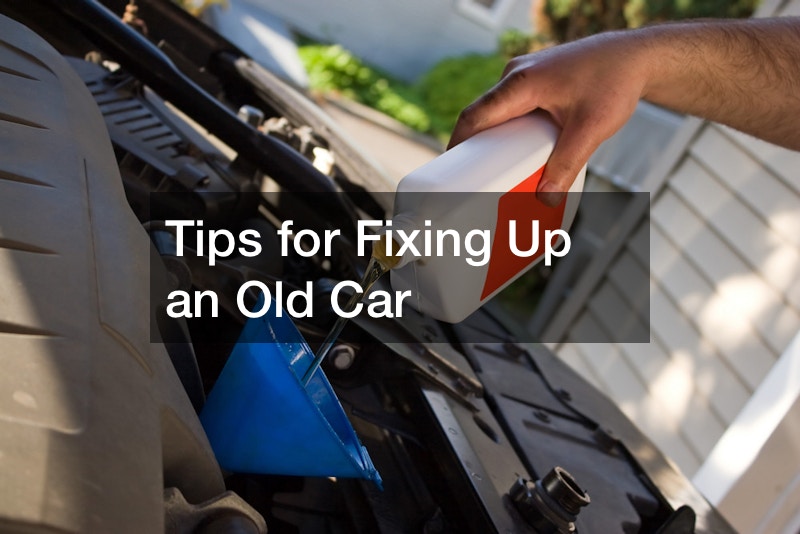Tips for Fixing Up an Old Car


A CBS News report clarified that fixing an old car is always cheaper than purchasing a new one. That might be the reason many Americans prefer fixing it up, even in the event of severe engine and transmission damage. Moreover, lower car insurance and adding aftermarket features are other benefits car owners enjoy by fixing older cars. Here are steps for a complete old car makeover:
1. Inspect It Carefully

Parking a car for a longer period exposes it to damage. Also, you may not be safe even by having it on the road, considering it has covered hundreds of miles. Call a professional to examine the car and help you estimate the costs before fixing it up.
The car engine oil only lubricates the moving parts when the engine runs. So, if you park your van or truck for an extended period, some components may get corrosion. On the other hand, components like the car battery discharge when the car is parked for a long time. This can also expose them to damage.
Apart from the engine, car tires deflate with time, and some parts rot. These invisible weak points make it necessary to change the tires. The brakes also rust due to inactivity, resulting in a loose grip. Another vital part of the car that gets damaged by long parking periods is the exterior due to rust. The damage level and the repair cost estimate will help you determine whether to continue fixing it up or buy a new one.
2. Schedule an Engine, Transmission, and Drivetrain Tune-Up

Riverdale Automotive argues that the average engine lifespan is around 150,000 to 200,000 miles. But the lifespan can reduce depending on your driving experience and road conditions. The same case with the transmission; they last for 300,000 miles if well maintained. But why should you check the engine, transmission, and drivetrain before other components?
The engine is the hottest part of a car. That’s why the internal combustion engines components like valves and pistons are prone to fast wearing out. The transmission has moving parts that form friction at all times. And the drivetrain has several moving parts.
During the full tune-up, your professional mechanic will check the engine’s condition. This is when you change the most damaged engine components like the oil pump, water pump, spark plugs or nozzles, and coolant pipes. Note that some cases, like the engine slow knock, will require a new engine or rebuilding an existing one.
The mechanic will determine the system condition by checking the automatic transmission fluid and the gear teeth. The drivetrain’s most essential parts are the propeller shaft, the differential axle, the wheel axles, and the bearings.
After inspecting the whole system, the mechanic will perform the minor service tasks like:
- Engine oil change
- Engine oil filter change
- Automatic transmission fluid change
- Differential fluid change
- Change the spark plugs; and
- Engine tuning for optimal performance
3. Prioritize the Advanced Systems (Power Steering, Brakes, AC, etc.)
The brake system, the power steering, AC, and other advanced systems are prone to damage after prolonged use or lack of use. The first cause of brake system damage is the failure to flush brake lines. Also, most power steering systems are hydraulic, which can wear out quickly.
Out of around 5.6 million car crashes in the United States yearly, 5% are caused by brake failure. That would amount to 300,000 accidents. On the other hand, around 2,000 accidents are caused by power steering failure in the United States every year, according to Amaro Law Firm report. Therefore, you must consider power steering and brake repair after the engine and the powertrain.
When inspecting the brake system, check for leaking or damaged brake fluid hoses. If any steel lines are damaged, replace them. Also, check the brake calipers and the master cylinder for leaks. Inspect the rotors for rust and use brake cleaner to remove rust. Finally, replace the brake pads and fill the system with the brake fluid.
The power steering system requires a simple check provided the hydraulic system is functional. You want to change the power steering fluid, check the wheel alignment, and confirm the approved rim width. Heating and air conditioning are also vital to keep the interior comfortable. The car AC is complicated, but the mechanic will clean the filters and fix the electrical parts.
The sunroof opening and closing mechanisms, window rolling up and down, and windscreen wiper system are some advanced systems to check when fixing it up. Afterward, you can access basic components like the lights and radio system.
4. Replace Other Damaged Parts

After inspecting and repairing the main system, check the basic components like headlights and taillights. You will also need the windshield wiper kits for the front and rear wiper changes. Rubbers in wipers wear out after exposure to the weather, as with other exterior components.
Luckily, most auto body garages have all the spare parts available. Their cost can be included in the whole car rebuild budget, or you would buy them separately. Replacing damaged parts is vital to the car’s aesthetics and safety.
Moreover, a damaged car exterior may expose you to fines because, normally, drunk drivers cause accidents and drive away from the scene. So, the authorities may regard damaged exterior components as hit and run. To avoid trouble with the traffic police, pay for automotive glass repair and other components to keep your car exterior neat.
5. Optimize Safety Features
According to a report, safety features like airbags have been used in vehicles since the early 1970s. Fortunately, they have reduced accident-related deaths by 34%. Combined with seat belts, they can reduce accident-related deaths by 61%. Safety features are essential when fixing it up, even if you own the earlier models with less advanced features.
Most safety optimization involves auto body repairs like the airbag sensor and other car exterior components. And the most common safety features you will find in 21st-century cars are:
- Lane departure warning system
- Blind spot monitor
- Seat belt
- Backup camera
- Adaptive cruise control
- Airbag system
- Tire-pressure monitoring system
- Anti-lock braking system
- Electronic stability control
- Collision avoidance systems
- Traction control
- Parking sensors
- Pedestrian detection
- Advanced driver-assistance system
- Brake assist
- Traffic-sign recognition
- Forward Collision Warning
- Rear cross-traffic alert
- Lane-keeping assist
6. Detail the Interior

Detailing the car interior is the first job you can do when professionals are fixing it up. Normally, it costs $200 to $350 to detail the interior at the shop, but this is a task you can set aside for yourself. This will help you cut the repair costs since a complete car makeover can cost thousands of dollars.
Detailing improves your car interior by replacing worn-out and outdated parts. However, you can perform this task after the mechanic has completed the most complex repair tasks. So, what does detailing entail when it comes to fixing it up? It’s the general improvement of the seats, roof, boot, floor mats, front panels, door panels, etc.
What items do you use to perform this task? Have a reliable car vacuum. Secondly, you need chemical products to clean stains from the seats and other interior surfaces. Third, treat the mold and mildew with white vinegar if the car has been parked long. And finally, you need polishing brushes.
Start by vacuuming the interior to remove excess dust. Under the seats rests a lot of dust and pests, so focusing on these areas is important. After vacuuming, clean the stains from the seats, dashboard, and mats. You can remove the mats and clean them outside the car.
If your car has a leather interior, it’s easy to clean because leather doesn’t absorb water. But you must spare some hours for the cloth interior to let it dry. Ideally, use laundry detergent or a mixture of baking soda and white vinegar to remove stains. Use one cup of white vinegar and a quarter cup of baking soda mixed with warm water.
Apply the mixture on the affected interior parts and scrub gently until the stains disappear. Then, use a clean microfiber cloth to dry the dump areas. Afterward, leave the car doors open for the air to circulate inside.
7. Do the Paint Job
Painting is the next thing when fixing it up. Note that car paints are prone to acidic bird poop, so they fade quickly. But you can’t do it yourself; car body experts will work on the exterior to restore the sparkling beauty.
Usually, the experts start by washing the car to get rid of the fine dust particles. After cleaning, they use the body filler to cover the dents and then sand the area to make it smooth. After the filler, auto body paint work starts, where professionals give the car several layers of paint depending on the body condition.
Due to grime and salt, you can add a few dollars for the underbody painting. Although many car owners overlook this essential service, it protects the car’s underbody from rusting. After the painting, wax the body to give the car a sparkling.
8. Do the Final Touches
What final touches would you do? Adding aesthetics like the roof racks, spoiler, and bull bar, if you are a true gearhead, are what entails the final touches. Also, swap the used tires with new ones that will enhance safety and performance. Clean the headlights to remove oxidation for better vision during the night.
If you are a person who loves privacy, you can do the auto tinting. But ensure you follow the tinting rules in your state. Most states don’t allow tinting the windshield and the front windows. Moreover, the tinting rules also state the tint levels in percentages.
9. Test Drive the Car
Do a test drive for at least 30 minutes and have your mechanic in the car to help determine areas needing more fixing. When test driving, taking the car on rough roads and the tarmac is best to note the performance. You will quickly notice car suspension problems on a rough road rather than a smooth road. The next things to note are the acceleration rate, the braking system, the steering system, and the safety features. Ensure everything functions well before getting the car back on the road.
10. Take Your Car for Inspection
It’s a recommendation to take your car for inspection. Specially licensed car technicians do the safety car inspections at any state DMVM location. Usually, the car will be inspected for safety and emissions. It should meet the standard emissions requirements according to the federal government.
Car safety is checked by inspecting the brakes, tires, lights, mirrors, and other advanced electronic systems. On the other hand, car emissions tests are done by connecting the car to the testing system through the car’s onboard diagnostic port. If you have an older car without modern features, they put it on a dynamometer and attach a sensor to the tailpipe. This helps to know the amount of greenhouse gases it emits.
11. Get a Car Insurance
After fixing it up, you must visit an insurance office to get help calculating your car insurance worth. Most companies have an online insurance calculator to help you calculate the charges easily. Driving a car without insurance first puts you at risk of not getting compensation in case of an accident. Secondly, it attracts fines of over $5000.
In some states, you also risk having your driver’s license suspended. Basically, insurance for older cars is cheaper than new cars. But if you have added after-market features, you may get additional insurance charges.
12. It’s Time to Get It Back On the Road
Once you fix your older car over purchasing a new one, you will have advantages like reduced cost, lower insurance, added aesthetics, and many more. However, fixing it up is a process that requires budgeting and hiring qualified professionals. Suppose the vehicle repair expenses exceed the costs of buying a new one; you should opt for a new car. That’s why inspecting the vehicle and calculating the cost before hiring a mechanic for a complete makeover is essential.


